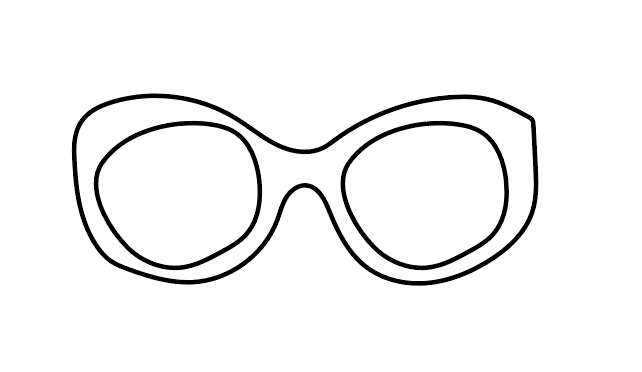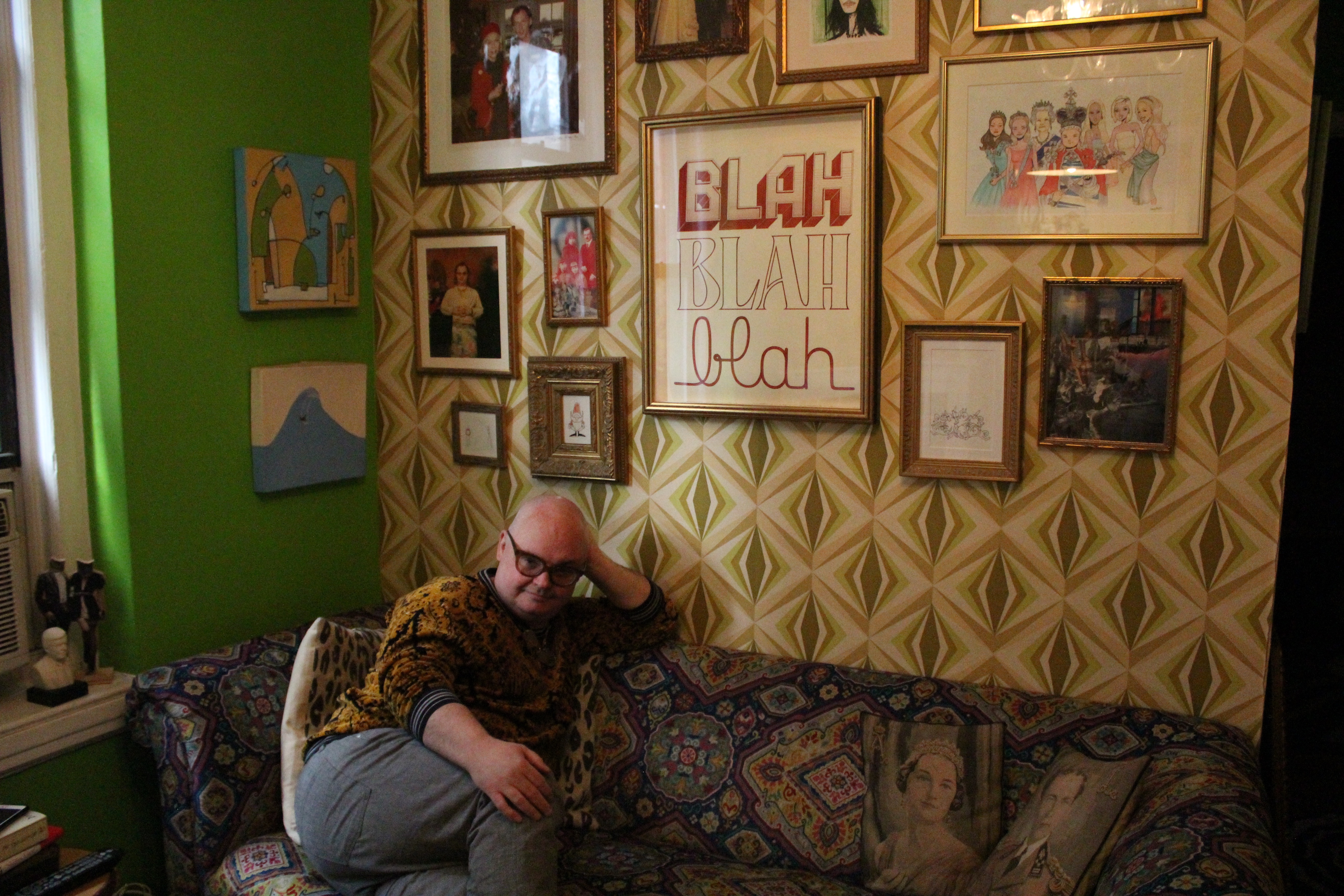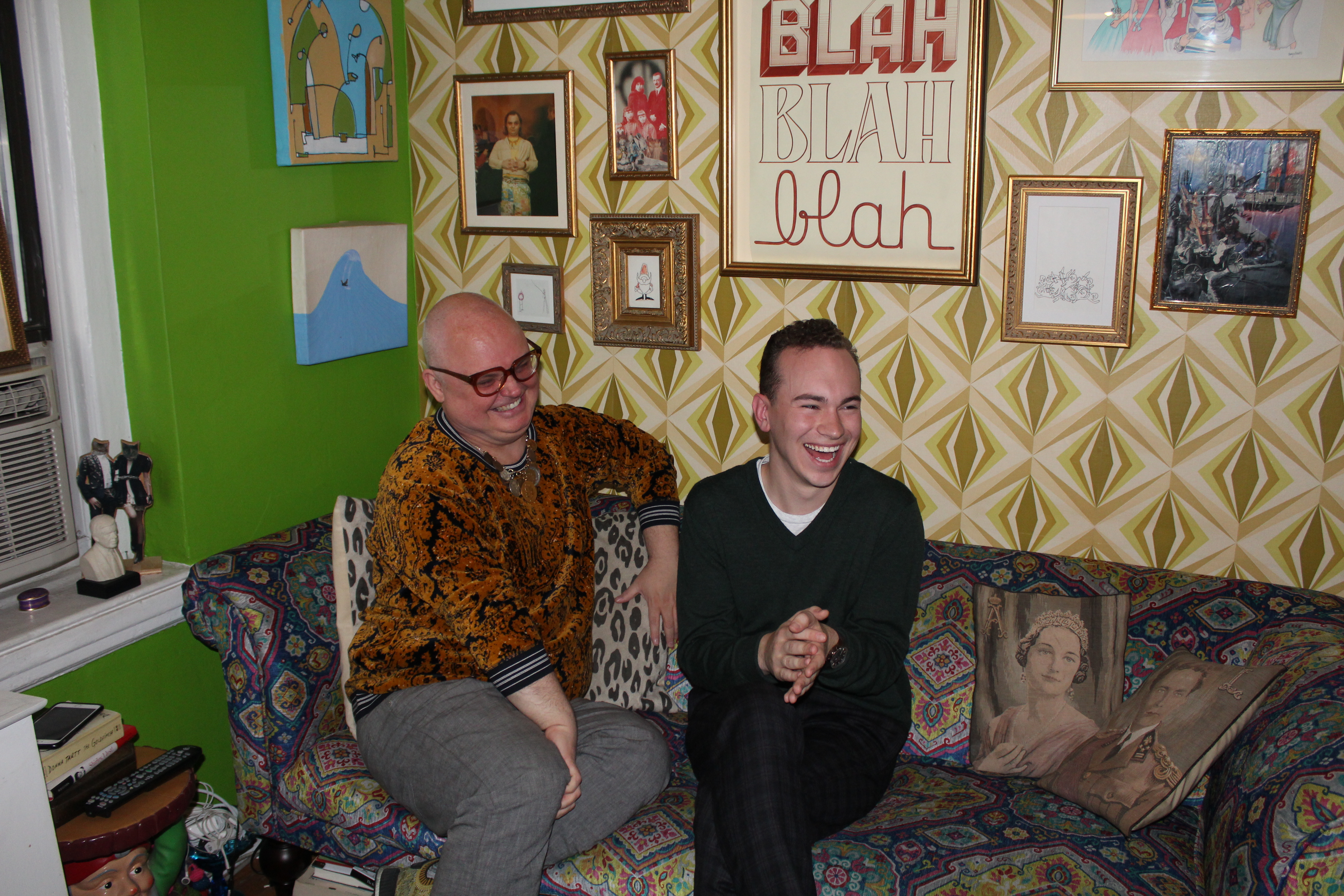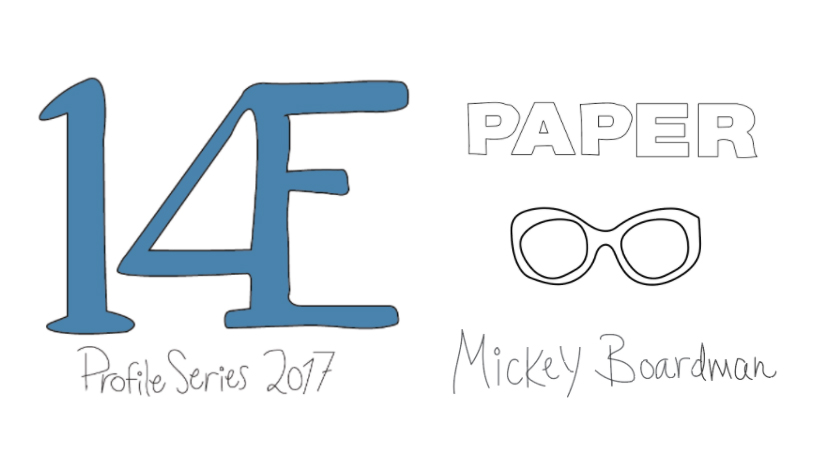Paper Magazine’s editorial director may rule New York, but he’ll always be a jewel in Chicagoland’s crown.
Michael Charles Boardman always had the feeling he needed to find where his people were. Even in Hanover Park, Illinois. As a young boy, Boardman knew that it wasn’t the Stepford Wives on his street that he’d hang out with one day. The closest thing to the future he wanted for himself in Hanover Park was the fourth grade Confraternity of Christian Doctrine (CCD) teacher, Mrs. Creek, who became the talk of the street for her divorce and subsequent interracial relationship. It probably wasn’t her divorce, or her relationship, that necessarily made him think they would be friends if they were the same age. But she was different. She didn’t seem boring.
Boardman (you can call him Mr. Mickey now) has grown his circle of friends, to say the least. His Instagram profile tells a visual fairy tale of a man jetsetting to every fashion week, working on shoots with Ciara, Bella Hadid, Kim Kardashian, and, just this month, Rihanna. Did we mention he was a judge for the Miss Universe pageant in Manila last month yet?
Mickey Boardman, editorial director of Paper Magazine, has taken the world by storm — and he’s one of us. A Chicagoland boy, Mickey was born in Skokie, Illinois, and later moved to Hanover Park. He attended Purdue University to study the Spanish language and studied abroad in Madrid. After Purdue was Parsons School of Design, where he butted heads with staff and didn’t finish school. But, after working the front desk at Paper and working his way up, Mickey is now a curator of style in America’s cultural capital. He is a social media connoisseur and an advocate for feminism. He’s been in the same apartment for 24 years, the same job for almost 25 years, and, having stumbled upon the perfect place for him, there’s no sign he’ll be leaving Paper (or his apartment) anytime soon.

(Patrick Pfohl, 14 East Magazine)
At Cafetal Social Club on Mott St. in New York City, Mr. Mickey sat in a Chloe sweater and custom-made necklace glimmering with foreign coins he’s collected over his years. The server there knew Mickey’s order and, upon exiting, he turned to me and said “any friend of his is a friend of ours.”
This is the point in the story where I should mention that my mother has many gay friends. However, only three have ever been given the title of “Guncle,” which you may have guessed is a portmanteau for gay uncle. Two out of the three guncles were on the infamous year-long study abroad trip in Madrid, Spain, that my parents both somehow survived.
I’m not sure whether there was an official knighting ceremony for Guncle Mickey that I was too young to remember, but I’m looking at the “Royal and noble ranks” Wikipedia page, thinking it needs an addition.
I grew up watching Mickey via Facebook and Twitter, desperately wanting to be him. Perhaps it was all of the fashion weeks he got to attend, or the people he got to interview. But, mostly, I just wanted to be happy like him. I was gay, too, (and still am, thank you very much) and watching Mickey’s life from afar was like walking toward the light at the end of the tunnel.
Moving to New York City to attend Parsons, Mickey decided he wanted to be a fashion designer. Really, he thinks he might have just wanted to go to New York City and be gay, which his family was “not that enthusiastic about.” They told him they would not be subsidizing a life they did not approve of — so he went anyway.
“That rocked their world,” Mickey said.

(Alexandra Amendola, 14 East Magazine)
Parsons ended up being the wrong fit for Mickey in his 20’s. Drug addiction, coupled with his artistic vision’s total clash with Parsons’ “commercial, 7th Avenue” vision at the time, landed him a failing grade in one of his classes senior year. Luckily, a friend he met abroad knew Paper’s managing editor at the time, and Mickey became an intern during his fashion studies.
Mickey always loved magazines; at 10 years old, he would buy Vogue magazines at his local Dominick’s grocery store.
He didn’t know what road he would take to get there, but Mickey calls himself an advocate of “positive visualization.” Paper was Mickey’s perfect fit. He loved them, they loved him, and he says he totally “blossomed.”
Before he failed one of his last classes at Parsons, he had already finished his first interview for Paper — Mickey sat across from the dreamy Rupert Everett, who was wearing a mesh tank top for half of the interview on the roof of the Peninsula Hotel. After he left Parsons, he started answering the phones at Paper. That was almost 25 years ago, and now he’s editorial director.
As editorial director, Mickey is far from what he thought he might be when he grew up. In Skokie, Mickey would watch the Good Humor man come around the neighborhood to sell ice cream and think to himself, “He’s so popular. If you were the Good Humor man, you must be so rich and popular because everyone’s excited to see you.” Confessing he didn’t truly know what he wanted to be when grew up, he says he always envisioned himself “driving a convertible, wearing fancy clothes, surrounded by glamour.”
Paper Magazine was founded in 1984 as a black and white, 16-page fold-out and has grown into a monthly digital and print magazine. In his 25 years at Paper, Mickey says the heart of Paper, discovering new talent, has always been there. The magazine has been the source for the coolest bands you haven’t heard of and the pulse of the up-and-coming in fashion. But, with the addition of “genius” creative director Drew Elliott (you may recognize him as a judge on VH1’s reboot of America’s Next Top Model), Paper has become more “pop culture-facing.”
In 2014, Paper “broke the internet” with Kim Kardashian’s cover shoot with photographer Jean-Paul Goude and, just this month, Paper is “breaking the rules” with Rihanna, sporting a spiked Lady-Liberty-meets-punk-rock hairstyle. Every cover rattles the notions of what can be seen in print, making headlines and hashtags every month.
Mickey admits he’s horrible at asking people for things (except money from his mother back in the day). But, he wouldn’t be where he is now if he couldn’t visualize what Paper needed from him for each issue.
Many of his experiences in Spain painted Mickey’s world with new colors: new understandings, new friends, new cultures, and new lessons. Mickey, being a magazine man himself, was locked and loaded with an anecdote to illustrate this for publication. As I sit back and listen, I realize that he’s doing a lot of my job for me. “Was he editorial directing my interview?” I dramatically ask myself using my perfected Carrie Bradshaw impression.

(Patrick Pfohl, 14 East Magazine)
The aforementioned anecdote begins:
“A happy life in the bathroom is the foundation of joy,” Mickey smirks. He’d never been constipated in his life until he got to Spain and he was deathly afraid of pooping anywhere but his home. Touring tiny Spanish towns, the moment had come. He certainly didn’t want to ask to use the bathroom in a bar. But, this was it. After three weeks of not going number two, he had to ask for help.
We’ll get back to pooping in Spain in a moment, but first we need to transport to Paper’s New York office to introduce TV’s Kirsten Dunst.
Kirsten Dunst and Jake Gyllenhaal came to Paper’s office in New York for a photoshoot for Dunst. Mickey had just been hired full-time. The always sexy Gyllenhaal, standing in stiff, blue Levi’s in an era of acid-wash denim, made Mickey feel some fuzzy feelings. Fear, anxiety, lust — Mickey was feeling all of it.
He was transported back to the bar in the tiny Spanish village. Standing with crossed legs, he thought to himself, “poop anywhere, anytime, regardless of the consequences, or you will die.”
And he “chose life.”
Time-traveling back to New York in his mind and swallowing his fear, he walked up to Dunst and Gyllenhaal to introduce himself. “Oh, we know each other,” Dunst said. “We’ve met!” They hadn’t.
He always remembers when he meets movie stars, which he said to me in a vaguely Bette Davis voice. His patterned Chloe sweater reminded me of Davis’ 1983 interview with Johnny Carson, when she wore a cheetah coat and matching cap.

(Patrick Pfohl, 14 East Magazine)
When I was first getting to know Mickey in high school as more than just a family friend, I thought he was a massive namedropper. He also didn’t like NBC’s SMASH, which put us at odds on my drama club’s New York City trip, but I guess that’s beside the point. Over the years, I’ve reached a different conclusion. Partying with Tory Burch. Hanging out at the office with Priyanka Chopra. Backstage at the Yeezy Season 5 NYFW show with Kim and Kylie. These are just the people that he interacts with on a day-to-day basis. These are his coworkers in his career as newsmaker.
“I never saw a famous person until I was 12 and I went to Woodfield Mall to see Grease. Johnny Morris, the sportscaster from Channel 2 was in line with his wife Jeanne Morris and I felt like I had seen Madonna.” It’s true that Madonna wasn’t a superstar yet, but you get what we’re saying.
It was this defecate-or-die motto that Mickey credits to his success. He learned that if he wanted to make it, he needed to be able to talk to anyone and ask for what he needed from them. Whether it’s a topic that the interviewee didn’t want to talk about or an opportunity for the magazine that would bring the story to life, Mickey knows what he wants and he asks for it.
And, he’s made it. In January, Mickey was a judge for the Miss Universe 2016 pageant in Manila and he showed up ready to shine. He chose his “black Ashish sparkle track suit and sequined leopard top,” according to his Feb. 4 New York Times article, titled “My Time as a Miss Universe Judge.”
But, on a serious note, Mickey wrote in the article that the Miss Universe pageant felt “uplifting and empowering” in a world where isolationism, walls, Trump and divisiveness dominate the headlines.
“I’m a feminist, and I know that pageants can been seen as a relic of bygone days,” Mickey wrote. “But I could see the women’s joy and satisfaction at being given a global platform to show off not only their legs but also their intelligence and accomplishments.”
It’s not every day that Mickey is published in the New York Times. But, with 39,600 Instagram followers and 61,800 Twitter followers, Mickey has the unique privilege of using social media as a platform for change.
Mickey’s Instagram feed is cluttered with pictures of Paper Magazine coverstars (if you haven’t seen Rihanna’s Break The Rules spread for March then go look at it here — I’ve already mentioned it twice), dazzlingly sparkly outfits at NYFW or PFW (there are so many FWs, who can keep up?), and many, many political pictures. Whether it’s a bright pink picture that says “FASHION STANDS WITH PLANNED PARENTHOOD,” regramming Women’s March pictures from all over the world, or a post on Trayvon Martin’s birthday, Mickey has mastered the art of social media activism. His diverse, curated profiles tell stories and stand up for what Mickey believes is right. His profiles use humor, wit, compassion and fashion to keep his followers engaged.
Mickey’s apartment is decorated with accent walls of bright green and (slightly yonic) wallpaper. Along the walls there are framed pieces of art — one is literally a sketch of a pile of dead babies, another that pictures a cartoon Mickey with some of the great royal women of Europe. The small space is littered with knickknacks and Mickey Memorabilia from over the years, including a framed picture of my parents above his kitchen cabinets. Yes, the Ladds were making out in a photobooth at Berlin, Chicago’s gay bar under the Belmont “L” stop, in the ‘90s. I have no idea why that’s there. Mickey doesn’t really answer my question, either.

(Alexandra Amendola, 14 East Magazine)
His favorite places in Chicago include IKRAM and IKRAM Cafe, (perhaps because Chicago fashion queen Ikram Goldman is another of Mickey’s anything-but-boring comrades) Millennium Park and the Architecture Boat Tour. His less-than-favorites include Water Tower Place, which, he says, has lost its glamour. Reminiscing, Mickey said, “I don’t know if it’s something about Chicago but, I just feel so happy about everything, in a way. It’s a lame thing mothers and parents say but, it’s just a great place to grow up. It has all the good stuff New York or L.A. has, but it also has super nice people and it has a human pace. It’s not brutal and hideous.”
After almost a quarter of a century (and half his life) at Paper, Mickey is thankful he’s ended up exactly where he’s supposed to be. He wishes the same for everyone else.
“One of the things [Drew Elliott] always says is ‘Everyone wants the best for you,’ except maybe Donald Trump. People want you to do well and people want you to succeed,” Mickey said.
His advice for young people looking to get into the creative world is to go to the creative worlds (New York, LA, Chicago) and surround yourself with creatives. “If you want to write a book, write a book.”
No one wants to see you fail.
Header illustration courtesy of Patrick Pfohl




NO COMMENT